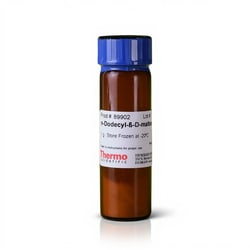Få mere at vide
Thermo Scientific™ Maltosidevaskemidler med høj renhed
Shop alle Thermo Scientific produkterBeskrivelse
Maltosidedetergenter er en klasse af ikke-ioniske overfladeaktive stoffer, der almindeligvis anvendes inden for membranproteinopløseliggørelse. Adskillige undersøgelser har vist, at disse overfladeaktive stoffer er yderst effektive til at ekstrahere og stabilisere membranproteiner. Maltosider hjælper også med oprensning og karakterisering af membranproteiner, hvilket letter downstream-applikationer såsom strukturel bestemmelse og funktionel analyse, hvilket gør dem til et vigtigt værktøj for forskere og videnskabsmænd, der arbejder på dette område.
Funktioner af maltoside vaskemidler
• Lipidlignende ikke-ionisk rengøringsmiddel
• Især nyttig til isolering og stabilisering af hydrofobe membranproteiner
• Bevarer aktiviteten af membranprotein bedre end de fleste rengøringsmidler
• Forbindelser med høj renhed med lav UV-absorptionsevne
n-Dodecyl-β -D-Maltoside
n-Dodecyl-β -D-Maltoside (DDM) er især nyttig til at solubilisere membranproteiner for at bevare deres aktivitet. Dette vandopløselige ikke-ioniske detergent bruges oftest til isolering af hydrofobe membranproteiner. Flere undersøgelser har vist, at n-dodecyl-β -D-maltosid er et skånsomt rengøringsmiddel, der ofte er i stand til at bevare proteinaktiviteten bedre end mange almindeligt anvendte rengøringsmidler, herunder NP-40, CHAPS og octyl-β -glukosid.
DDM's egenskaber
•Samlingsnummer: 98 (gennemsnit), 70 til 140 rækkevidde
•Micelle molekylvægt: 50.000 g
•CMC: 0,17 mM (0,009 %, vægt/volumen) i vand; 0,12 mM (0,006 %, vægt/volumen) i 0,2 M NaCl
DDM/CHS-opløsning
DDM/CHS Solution (10:1) er en klar-til-brug opløsning til solubilisering af membranproteiner, samtidig med at strukturel integritet og aktivitet bevares. Den stabile præformulerede opløsning indeholder en blanding af dodecyl-β -D-maltosid (DDM) (100 mg/mL) og cholesterylhemisuccinat (CHS) (10 mg/mL) i deioniseret vand med slutkoncentrationer på henholdsvis 10 % og 1 %. Typiske arbejdskoncentrationer er 1 % DDM/0,1 % CHS til proteinekstraktion og 0,1 % DDM/0,01 % CHS til proteinoprensning. Blandingen af ikke-ionisk detergent, DDM, med dobbelte hydrofobe/hydrofile egenskaber og anionisk detergent, CHS, hjælper med at stabilisere store unilamellære vesikler og er velegnet til proteinsolubilisering og stabilisering til cryo-EM-analyse af enkeltpartikler.
Yderligere egenskaber ved CHS
• Molekylformel: C31H50O4·C4H11NO3
• Molekylvægt: 607,9 g/mol
• Vaskepulver: ioniserbar anionisk
• Fungere: stabiliserer store unilamellære vesikler
Lauryl Maltose Neopentyl Glycol
Lauryl Maltose Neopentyl Glycol (LMNG) er et amfifilt detergent, der er ideelt egnet til at forbedre solubilisering af integrerede membranproteiner, samtidig med at strukturel integritet og aktivitet bevares.
LMNG har to koblede hydrofobe kæder af samme længde og to hydrofile maltosidgrupper for bedre at efterligne det integrerede membranproteinmiljø. Miceller er kendt for at hjælpe med solubilisering af membranproteiner, mens de bevarer struktur og funktion, herunder G-proteinkoblede receptorer (GPCR'er). LMNG er velegnet til proteinsolubilisering og stabilisering til enkeltpartikel-kryo-EM-analyse.
Egenskaber af LMNG
• Kemisk navn: 2,2-didecylpropan-1,3-bis-β -D-maltopyranosid
• Molekylvægt: 1005,19 g/mol
• CMC: (H 2 O)∼ 0,01 mM, (0,001 %)
• Renhed: ≥ 98 % alle anomerer (ved HPLC-analyse)
LMNG/CHS-løsning
LMNG/CHS Solution (10:1) er en klar-til-brug formulering til solubilisering af integrerede membranproteiner, samtidig med at strukturel integritet og aktivitet bevares. Den stabile præformulerede opløsning indeholder en blanding af laurylmaltose neopentylglycol (LMNG) (5%) og cholesterylhemisuccinat (CHS) (0,5%) i deioniseret vand. Typiske arbejdskoncentrationer for proteinekstraktion er 1 % LMNG/0,1 % CHS og 0,01 % LMNG/0,001 % CHS til proteinoprensning og strukturbestemmelse. LMNG/CHS-miceller hjælper med solubilisering af membranproteiner, mens de bevarer struktur og funktion, herunder G-proteinkoblede receptorer (GPCR'er), og er velegnet til proteinsolubilisering og stabilisering til enkeltpartikel-kryo-EM-analyse.
n-Undecyl-β -D-Maltopyranosid
n-Udecyl-β -D-Maltopyranosid (UDM) har en undecyl (C11) alkylkæde knyttet til maltose hovedgruppen. Den længere alkylkædelængde af UDM bidrager til dets forbedrede solubiliseringseffektivitet for visse membranproteiner. Den øgede hydrofobicitet af undecylkæden kan lette stærkere interaktioner med hydrofobe områder af membranproteiner, hvilket fører til forbedret solubilisering og stabilisering. Den længere undecylkædelængde i UDM kan også resultere i en højere CMC sammenlignet med maltosider med kortere alkylkæder. Dette kan påvirke dannelsen og stabiliteten af miceller i opløsning.
Egenskaber ved UDM
•CMC: ( H2O ) -0,59 mM(1) (0,029%)
•Aggregeringsnummer: ~71 (100 mM NaCl, 20 mM HEPES pH 7,5)
•Renhed:≥ 99 %β +α (ved HPLC-analyse)
n-nonyl-beta-maltosid
n-Nonyl-Beta-Maltoside (NM) har en nonyl (C9)-alkylkæde knyttet til maltosehovedgruppen. Denne specifikke kædelængde giver NM distinkte solubiliserings- og stabiliseringsegenskaber sammenlignet med andre maltosider med forskellige alkylkædelængder, såsom octyl- eller decylmaltosid. Den specifikke alkylkædelængde af NM påvirker dets micelleegenskaber og bidrager til en relativt lav CMC. Denne egenskab muliggør dannelsen af stabile miceller ved lavere koncentrationer, hvilket er vigtigt for at opretholde stabiliteten og integriteten af membranproteiner under solubilisering og efterfølgende eksperimenter.
Egenskaber ved NM
•CMC: ( H2O ) ~ 6 mM (0,28%)
•Aggregeringsnummer: ~55 (100 mM NaCl, 20 mM HEPES pH 7,5)
•Renhed:≥ 99 %β +α (ved HPLC-analyse)
n-oktyl-β -D-Maltopyranosid
n-oktyl-β -D-Maltopyranosid (OM) har en octyl (C8) alkylkæde knyttet til maltosehovedgruppen. Den specifikke alkylkædelængde af OM adskiller den fra andre maltosider med forskellige alkylkædelængder, såsom nonyl- eller decylmaltosid. Octylkædelængden i OM bidrager til en relativt lav CMC, hvilket muliggør dannelsen af stabile miceller ved lavere koncentrationer. Denne egenskab er vigtig for at opretholde stabiliteten og integriteten af membranproteiner under solubilisering og efterfølgende eksperimenter. OM er alsidig og finder anvendelse inden for forskellige områder af membranproteinforskning, proteinkrystallisering og biokemiske undersøgelser. Det kan bruges i en lang række eksperimentelle forhold, buffersystemer og pH-områder. OM tilbyder fleksibilitet og kompatibilitet med forskellige eksperimentelle opsætninger.
Egenskaber for OM
•CMC: (100 mM NaCl, 20 mM HEPES pH 7,5) ~ 19,5 mM(1) (0,89 %)
•Aggregeringsnummer: ~47 (100 mM NaCl, 20 mM HEPES pH 7,5)
•Renhed:≥ 99 %β +α (ved HPLC-analyse)

Tekniske data
Tekniske data
| Produkttype | Detergent |
| Indhold og opbevaring | Store below –20°C. |
| Form | Powder |
| Reagenstype | n-Dodecyl-β-D-Maltoside |
| Mængde | 1 g |
| Molekylvægt (g/mol) | 510.6 g/mol |
Må kun benyttes til forskning.
Dit input er vigtigt for os. Udfyld denne formular for at give feedback relateret til indholdet på dette produkt.
